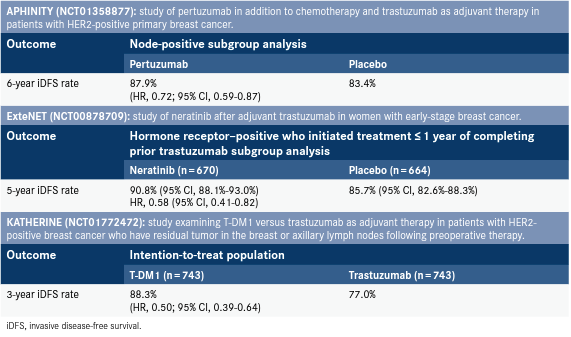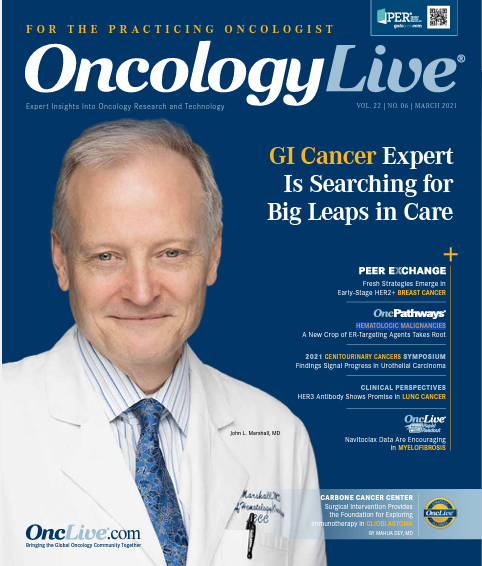Experts Take a Fresh Look at Strategies for Early-Stage HER2+ Breast Cancer
Although trastuzumab-based regimens remain the standard treatment for patients with early-stage HER2-positive breast cancer, unanswered clinical questions surround the use of other agents in the neoadjuvant and adjuvant settings.
Lisa A. Carey, MD

Although trastuzumab (Herceptin)-based regimens remain the standard treatment for patients with early-stage HER2-positive breast cancer, unanswered clinical questions surround the use of other agents in the neoadjuvant and adjuvant settings. With several options on the table, risk-adapted approaches to therapy have paved the way for personalized medicine and the opportunity to move away from therapies with higher toxicity profiles, such as anthracyclines.
“The debates that are going on are what’s the appropriate chemotherapy backbone and do you need an anthracycline, for example?” Lisa A. Carey, MD, said during a recent OncLive Peer Exchange®. “What’s the extent to which we need all those drugs, and can we rationally optimize therapy even for patients at higher clinical risk?”
A panel of breast cancer experts examined neoadjuvant and adjuvant systemic therapy approaches for patients with HER2-positive early-stage breast cancer. They also unpacked key updates to clinical trial data and shared how these affect their decision-making.
Reexamining Neoadjuvant Standards of Care
“We’re treating the majority of patients with HER2-positive breast cancer in the neoadjuvant setting. They’re getting their chemotherapy and anti-HER2 targeting preoperatively, for the most part, and then [postoperative] HER2 targeting is predicated on extent of disease that’s found at surgery,” Carey said, noting this approach has shown several benefits. “You can create more lobectomy candidates and can reduce the need for axillary dissection.”
It also enables oncologists to see how responsive a patient’s tumor is to their neoadjuvant regimen, enabling better tailoring of postoperative adjuvant treatment. For example, in the KATHERINE trial (NCT01772472), adjuvant ado-trastuzumab emtansine (Kadcyla; T-DM1) was associated with better outcomes than trastuzumab alone in patients who had residual invasive disease after completing neoadjuvant therapy.1
A key ongoing question for patients with HER2-positive disease is which neoadjuvant regimen is best. In the preoperative setting, Carey said she typically uses TCH (docetaxel [Taxotere], carboplatin, trastuzumab), adding pertuzumab (Perjeta) for patients with node-positive disease, but not for those with node-negative disease, per the APHINITY trial (NCT01358877) data. Six-year follow-up data showed patients who were node-positive continued to derive a benefit from the addition of pertuzumab, demonstrating a 4.5% absolute improvement in invasive disease–free survival, regardless of their hormone receptor status.2
“I shifted a little while ago more toward TCHP [docetaxel, trastuzumab, pertuzumab, carboplatin], although I do find that it’s a difficult regimen,” Claudine Isaacs, MD, said. “From a symptom-control perspective, it’s one of the toughest regimens we give.”
Claudine Isaacs, MD

Overall, the participants agreed that they no longer use anthracyclines as they once did. “The TRAIN-2 data were further evidence for us that the anthracyclines really didn’t add much,” Isaacs said. The phase 3 TRAIN-2 study (NCT01996267) looked at chemotherapy with or without anthracyclines in the presence of dual HER2-blockade for HER2-positive breast from anthracyclines, which should be the ultimate goal. Claudine Isaacs, MD cancer.3 Three-year follow-up showed an estimated event-free survival of 92.7% for the anthracycline cohort versus 93.6% in the nonanthracycline cohort, with 3-year overall survival (OS) estimates of 97.7% and 98.2%, respectively. Two patients in the anthracycline cohort developed acute leukemia. These findings confirmed the results of the primary outcome analysis, which was that anthracyclines do not improve treatment efficacy and are associated with clinically relevant toxicity.3
Despite these data, Vijayakrishna Gadi, MD, PhD, noted that some patients in his practice who are HER2-positive still receive anthracyclines. “For patients who have substantial burden of disease— maybe somebody who has not been [screened] but walks in with a big mass—I frequently start with the taxane portion, and then I’m on the fence a little on the anthracycline, [but] most of those patients still end up [receiving] the anthracycline in my practice,” he said. “There [are] always going to be patients whose circumstances are different, where you think you need to escalate in that direction and offer more with an anthracycline or what have you,” he explained.
Vijayakrishna Gadi, MD, PhD

Moderator Joyce A. O’Shaughnessy, MD, added that part of the concern about relying on TRAIN-2 data regarding the role of anthracyclines is that it is a relatively small trial with fewer than 500 patients. Nevertheless, she said, the data are still encouraging because they show it is possible to move away from anthracyclines, which should be the ultimate goal.
Identifying and Treating Patients at High Risk of Recurrence After Neoadjuvant Therapy
“In my mind, the fundamental thing that defines risk after receiving neoadjuvant therapy is what the residual disease burden looks like. If there’s significant disease, particularly in nodes, that would be very worrisome, as it would be if there’s a significant amount of disease in the breast,” William J. Gradishar, MD, said. He also noted that anyone who progresses while on neoadjuvant therapy would be considered high risk but said this is not something he has frequently observed.
William J. Gradishar, MD

The participants agreed that T-DM1 is the standard of care for patients with residual disease after TCHP or AC-THP (doxorubicin, cyclophosphamide, paclitaxel, trastuzumab, pertuzumab). “Most patients do OK with it, so I would try to leverage that benef it that we saw in KATHERINE and confer [it on] whoever has residual disease,” he said.
Gadi said he struggles a bit with treatment decision-making when it comes to patients who are node-positive and achieve a pathologic complete response (pCR). “You look at some of the trials, and you start picking at them a little. There seems to be a suggestion that maybe you should continue the [trastuzumab and pertuzumab]. I have to be honest; I don’t find that data compelling,” he said, noting that he often continues only the trastuzumab and not the pertuzumab in these patients.
“I don’t think we know the right thing to do,” Carey said. She added that if she observed a pCR out of a trastuzumab/pertuzumab–based regimen, her tendency would be to continue the combination. Isaacs agreed. “I tend to continue trastuzumab and pertuzumab, as well, if somebody is tolerating it and there’s no compelling reason to stop it,” she said.
O’Shaughnessy mentioned that the FDA label for pertuzumab is interesting because it indicates that if this agent is used preoperatively, it should be continued for 1 year postoperatively. The label states, “Following surgery, patients should continue to receive [pertuzumab] and trastuzumab or trastuzumab/hyaluronidase-oysk [Herceptin Hylecta] to complete 1 year of treatment (up to 18 cycles).”4 However, she noted that it is still unclear whether this is necessary. “If someone has a pCR, do they really need it?” she asked.
Joyce A. O’Shaughnessy, MD

Adjuvant Systemic Therapy: Implications of Data Updates
The participants also discussed recent updates to key adjuvant therapy trials, including APHINITY, ExteNET, and KATHERINE, and shared how these data may affect clinical practice.
APHINITY Trial
Isaacs discussed a subpopulation treatment effect pattern plot (STEPP) analysis of the APHINITY trial, which was presented at the 2020 San Antonio Breast Cancer Symposium Virtual Annual Meeting.5 “What came out was very much in keeping with what we thought, that the group that derived the greatest benefit were the patients who had higher clinical risk,” she said. In the study, patients with HER2-positive, node-positive early-stage breast cancer benefited the most from the addition of adjuvant pertuzumab (as compared with patients with node-negative early-stage breast cancer), with benefit seen irrespective of STEPP subpopulation; however, the largest gains were for patients with lower-risk node-positive disease and those with the highest number of tumor-infiltrating lymphocytes (TILs) (Table3,5,6).
Table. Select Data from Adjuvant Therapy Trials3,5,6

Isaacs noted that although the information on TILs is interesting, it is difficult to apply in practice. “We’re not necessarily getting TIL numbers when we’re getting path specimens on patients who are getting core biopsies,” she said. However, even without knowing patients’ TIL status, she noted the data further support current clinical practice regarding the use of adjuvant pertuzumab for patients with HER2-positive, early-stage breast cancer.
ExteNET Trial
Next, Isaacs reviewed the final OS analysis of the randomized phase 3 ExteNET trial (NCT00878709), which included 2840 patients with estrogen receptor (ER)–positive, HER2-positive early breast cancer who were treated with neratinib (Nerlynx) or placebo after neoadjuvant/adjuvant trastuzumab-based therapy.6 “There emerged a survival benefit [with neratinib]—an approximate 2% survival benefit—if you looked at the super-highest risk: the [patients who were] hormone receptor–positive who started within a year of completing their therapy, and the ones who didn’t achieve a pCR,” Isaacs said.
A challenge she noted is knowing where the drug fits in during the era of T-DM1 and pertuzumab. “In the really high-risk patients, particularly if they have hormone receptor–positive disease—and we all have some patients who have multiple nodes, 2 or 3 nodes—I do tend to give them neratinib,” she said.
Gadi said he has been using neratinib more frequently recently. “I believe that ER-positive disease is fundamentally different from the kind that’s ER negative. If we don’t address that cross talk, and we don’t do that with T-DM1, I’m still worried about these patients having events down the road,” he explained. He also noted that what makes neratinib appealing to him is its ability to cross the blood-brain barrier. “I know that trials are underpowered for CNS [central nervous system] as a first site of recurrent type event. It’s my suspicion that those are patients who are vulnerable to those events when you have residual disease, have done T-DM1, and have ER-positive disease. I’d like to give them that extra bit of coverage for that, as well as for prevention of those CNS events,” he said.
The challenge with neratinib, however, is its adverse effect profile, particularly diarrhea, which can make it difficult for patients to tolerate.7 Subsequently, Gradishar said he does not use it a lot, but he agreed that he would use it for patients such as Isaacs described, adding that patients and oncologists both need to be highly motivated for the patient to be able to get through this treatment. Because of this agent’s toxicities, O’Shaughnessy emphasized the importance of escalating it per the findings from the CONTROL trial (NCT02400476), which investigated antidiarrheal strategies in patients with early HER2-positive breast cancer treated with neratinib.8 In the study, both preemptive prophylaxis and dose escalation reduced the rate, severity, and duration of grade 3 diarrhea compared with the levels observed in ExteNET, but dose escalation was particularly promising, with only 3% of patients on this strategy discontinuing treatment due to diarrhea.
“In the CONTROL trial, they escalated relatively quickly. I was surprised...It was the most effective,” Carey said. She said when she has a patient whose cancer is very high risk, she sometimes uses neratinib. “I’ve been happier with the option of dose escalation,” she said.
KATHERINE Trial
Data from the KATHERINE trial showed that among patients with HER2-positive early breast cancer who had residual invasive disease after completion of neoadjuvant therapy, the risk of recurrence of invasive breast cancer or death was 50% lower with adjuvant T-DM1 than with trastuzumab alone.1 “I was really impressed by the KATHERINE data. [The data] showed this really big 3-year, invasive disease–free survival benefit for the patients who didn’t achieve a pCR [in the neoadjuvant setting]. It’s approximately an 11% absolute benefit,” Isaacs said.
Recently, exploratory analyses evaluating the relationship between invasive disease–free survival and biomarkers potentially related to response showed that PIK3CA mutation status did not influence outcomes with trastuzumab or T-DM1, and that T-DM1 benefit was not affected by any of the biomarkers assessed; however, HER2 and PD-L1 expression levels correlated with outcomes in the trastuzumab arm.9
Based on the KATHERINE data, the American Society of Clinical Oncology recently updated its guidelines on the selection of optimal adjuvant chemotherapy and targeted therapy for early breast cancer.10 It now strongly recommends that patients with HER2-positive breast cancer with pathologic invasive residual disease at surgery after standard preoperative chemo-therapy and HER2-targeted therapy be offered 14 cycles of adjuvant trastuzumab emtansine, unless there is disease recurrence or unmanageable toxicity. The guidelines note that clinicians may offer any of the available and approved formulations of trastuzumab, including trastuzumab, trastuzumab and hyaluronidase-oysk, and available biosimilars.
References
- von Minckwitz G, Huang CS, Mano MS, et al; KATHERINE Investigators. Trastuzumab emtansine for residual invasive HER2-positive breast cancer. N Engl J Med. 2019;380(7):617-628. doi:10.1056/NEJMoa1814017
- Piccart M, Procter M, Fumagalli D, et al. Interim overall survival analysis of APHINITY (BIG 4-11): a randomized multicenter, double-blind, placebo-controlled trial comparing chemotherapy plus trastuzumab plus pertuzumab versus chemotherapy plus trastuzumab plus placebo as adjuvant therapy in patients with operable HER2-positive early breast cancer. Paper presented at: 2019 San Antonio Breast Cancer Symposium; December 10-14, 2019; San Antonio, TX. Accessed February 21, 2021. https://www.abstractsonline.com/pp8/#!/7946/presentation/2040
- van der Voort A, van Ramshorst MS, van Werkhoven ED, et al; Dutch Breast Cancer Group (BOOG). Three-year follow-up of neoadjuvant chemotherapy with or without anthracyclines in the presence of dual HER2-blockade for HER2-positive breast cancer (TRAIN-2): a randomized phase III trial. J Clin Oncol. 2020;38(suppl 15):501. doi:10.1200/JCO.2020.38.15_suppl.501
- Perjeta. Prescribing information. Genentech Inc; 2020. Accessed February 24, 2021. https://www.accessdata.fda.gov/drugsatfda_docs/label/2020/125409s124lbl.pdf
- Gelber RD, Wang XV, Cole BF, et al. 6-year absolute invasive disease-free survival (IDFS) benefit of adding adjuvant pertuzumab to trastuzumab and chemotherapy for patients with early HER2-positive breast cancer: a STEPP analysis of the APHINITY (BIG 4-11) trial. Paper presented at: 2020 San Antonio Breast Cancer Symposium, December 8-11, 2020; virtual. doi:10.1158/1538-7445.SABCS20-PS10-01
- Chan A, Moy B, Mansi J, et al; ExteNET Study Group. Final efficacy results of neratinib in HER2-positive hormone receptor-positive early-stage breast cancer from the phase III ExteNET trial. Clin Breast Cancer. 2021;21(1):80-91.e7. doi:10.1016/j.clbc.2020.09.014
- Nerlynx. Prescribing information. Puma Biotechnology Inc; 2020. Accessed February 24, 2021. https://www.accessdata.fda.gov/drugsatfda_docs/label/2020/208051s007lbl.pdf
- Barcenas CH, Hurvitz SA, Di Palma JA, et al; CONTROL Study Investigators. Improved tolerability of neratinib in patients with HER2-positive early-stage breast cancer: the CONTROL trial. Ann Oncol. 2020;31(9):1223-1230. doi:10.1016/j.annonc.2020.05.012
- Denkert C, Lambertini C, Fasching PA, et al. Biomarker data from KATHERINE: a phase III study of adjuvant trastuzumab emtansine (T-DM1) versus trastuzumab (H) in patients with residual invasive disease after neoadjuvant therapy for HER2-positive breast cancer. J Clin Oncol. 2020;38(suppl 15):502. doi:10.1200/JCO.2020.38.15_suppl.502
- Denduluri N, Somerfield MR, Chavez-MacGregor M, et al. Selection of optimal adjuvant chemotherapy and targeted therapy for early breast cancer: ASCO guideline update. J Clin Oncol. 2021;39(6):685-693. doi:10.1200/JCO.20.02510




